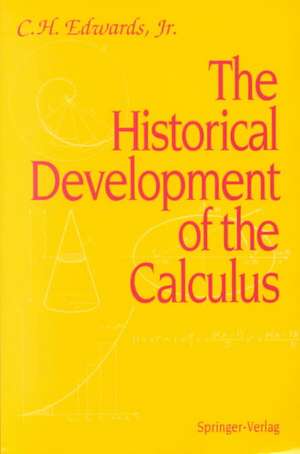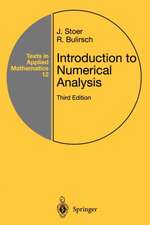The Historical Development of the Calculus: Springer Study Edition
Autor C.H.Jr. Edwardsen Limba Engleză Paperback – 24 iun 1994
Din seria Springer Study Edition
-
 Preț: 386.26 lei
Preț: 386.26 lei -
 Preț: 370.79 lei
Preț: 370.79 lei -
 Preț: 296.06 lei
Preț: 296.06 lei -
 Preț: 403.37 lei
Preț: 403.37 lei -
 Preț: 508.91 lei
Preț: 508.91 lei - 23%
 Preț: 921.30 lei
Preț: 921.30 lei -
 Preț: 403.37 lei
Preț: 403.37 lei -
 Preț: 389.70 lei
Preț: 389.70 lei -
 Preț: 389.70 lei
Preț: 389.70 lei - 5%
 Preț: 1122.94 lei
Preț: 1122.94 lei - 5%
 Preț: 370.38 lei
Preț: 370.38 lei -
 Preț: 406.25 lei
Preț: 406.25 lei - 15%
 Preț: 530.58 lei
Preț: 530.58 lei -
 Preț: 398.35 lei
Preț: 398.35 lei - 5%
 Preț: 368.73 lei
Preț: 368.73 lei - 15%
 Preț: 633.02 lei
Preț: 633.02 lei -
 Preț: 392.75 lei
Preț: 392.75 lei - 15%
 Preț: 588.69 lei
Preț: 588.69 lei - 20%
 Preț: 660.99 lei
Preț: 660.99 lei - 20%
 Preț: 663.61 lei
Preț: 663.61 lei - 15%
 Preț: 640.88 lei
Preț: 640.88 lei - 15%
 Preț: 654.43 lei
Preț: 654.43 lei -
 Preț: 390.46 lei
Preț: 390.46 lei - 15%
 Preț: 652.81 lei
Preț: 652.81 lei -
 Preț: 394.87 lei
Preț: 394.87 lei - 15%
 Preț: 642.03 lei
Preț: 642.03 lei - 15%
 Preț: 688.99 lei
Preț: 688.99 lei - 15%
 Preț: 642.36 lei
Preț: 642.36 lei - 15%
 Preț: 635.15 lei
Preț: 635.15 lei -
 Preț: 396.62 lei
Preț: 396.62 lei - 18%
 Preț: 893.21 lei
Preț: 893.21 lei -
 Preț: 419.14 lei
Preț: 419.14 lei -
 Preț: 423.34 lei
Preț: 423.34 lei - 20%
 Preț: 377.27 lei
Preț: 377.27 lei - 18%
 Preț: 742.97 lei
Preț: 742.97 lei - 15%
 Preț: 655.27 lei
Preț: 655.27 lei - 20%
 Preț: 336.02 lei
Preț: 336.02 lei -
 Preț: 397.38 lei
Preț: 397.38 lei
Preț: 502.73 lei
Preț vechi: 591.44 lei
-15% Nou
Puncte Express: 754
Preț estimativ în valută:
96.21€ • 104.47$ • 80.82£
96.21€ • 104.47$ • 80.82£
Carte tipărită la comandă
Livrare economică 23 aprilie-07 mai
Preluare comenzi: 021 569.72.76
Specificații
ISBN-13: 9780387943138
ISBN-10: 0387943137
Pagini: 368
Ilustrații: XII, 368 p.
Dimensiuni: 155 x 235 x 20 mm
Greutate: 0.51 kg
Ediția:1st ed. 1979. Corr. 3rd printing 1994
Editura: Springer
Colecția Springer
Seria Springer Study Edition
Locul publicării:New York, NY, United States
ISBN-10: 0387943137
Pagini: 368
Ilustrații: XII, 368 p.
Dimensiuni: 155 x 235 x 20 mm
Greutate: 0.51 kg
Ediția:1st ed. 1979. Corr. 3rd printing 1994
Editura: Springer
Colecția Springer
Seria Springer Study Edition
Locul publicării:New York, NY, United States
Public țintă
Lower undergraduateCuprins
1 Area, Number, and Limit Concepts in Antiquity.- Babylonian and Egyptian Geometry.- Early Greek Geometry.- Incommensurable Magnitudes and Geometric Algebra.- Eudoxus and Geometric Proportions.- Area and the Method of Exhaustion.- Volumes of Cones and Pyramids.- Volumes of Spheres.- References.- 2 Archimedes.- The Measurement of a Circle.- The Quadrature of the Parabola.- The Area of an Ellipse.- The Volume and Surface Area of a Sphere.- The Method of Compression.- The Archimedean Spiral.- Solids of Revolution.- The Method of Discovery.- Archimedes and Calculus?.- References.- 3 Twilight, Darkness, and Dawn.- The Decline of Greek Mathematics.- Mathematics in the Dark Ages.- The Arab Connection.- Medieval Speculations on Motion and Variability.- Medieval Infinite Series Summations.- The Analytic Art of Viète.- The Analytic Geometry of Descartes and Fermat.- References.- 4 Early Indivisibles and Infinitesimal Techniques.- Johann Kepler (1571–1630).- Cavalieri’s Indivisibles.- Arithmetical Quadratures.- The Integration of Fractional Powers.- The First Rectification of a Curve.- Summary.- References.- 5 Early Tangent Constructions.- Fermat’s Pseudo-equality Methods.- Descartes’ Circle Method.- The Rules of Hudde and Sluse.- Infinitesimal Tangent Methods.- Composition of Instantaneous Motions.- The Relationship Between Quadratures and Tangents.- References.- 6 Napier’s Wonderful Logarithms.- John Napier (1550–1617).- The Original Motivation.- Napier’s Curious Definition.- Arithmetic and Geometric Progressions.- The Introduction of Common Logarithms.- Logarithms and Hyperbolic Areas.- Newton’s Logarithmic Computations.- Mercator’s Series for the Logarithm.- References.- 7 The Arithmetic of the Infinite.- Wallis’ Interpolation Scheme and Infinite Product.-Quadrature of the Cissoid.- The Discovery of the Binomial Series.- References.- 8 The Calculus According to Newton.- The Discovery of the Calculus.- Isaac Newton (1642–1727).- The Introduction of Fluxions.- The Fundamental Theorem of Calculus.- The Chain Rule and Integration by Substitution.- Applications of Infinite Series.- Newton’s Method.- The Reversion of Series.- Discovery of the Sine and Cosine Series.- Methods of Series and Fluxions.- Applications of Integration by Substitution.- Newton’s Integral Tables.- Arclength Computations.- The Newton-Leibniz Correspondence.- The Calculus and the Principia Mathematica.- Newton’s Final Work on the Calculus.- References.- 9 The Calculus According to Leibniz.- Gottfried Wilhelm Leibniz (1646–1716).- The Beginning—Sums and Differences.- The Characteristic Triangle.- Transmutation and the Arithmetical Quadrature of the Circle.- The Invention of the Analytical Calculus.- The First Publication of the Calculus.- Higher-Order Differentials.- The Meaning of Leibniz’ Infinitesimals.- Leibniz and Newton.- References.- 10 The Age of Euler.- Leonhard Euler (1707–1783).- The Concept of a Function.- Euler’s Exponential and Logarithmic Functions.- Euler’s Trigonometric Functions and Expansions.- Differentials of Elementary Functions à la Euler.- Interpolation and Numerical Integration.- Taylor’s Series.- Fundamental Concepts in the Eighteenth Century.- References.- 11 The Calculus According to Cauchy, Riemann, and Weierstrass.- Functions and Continuity at the Turn of the Century.- Fourier and Discontinuity.- Bolzano, Cauchy, and Continuity.- Cauchy’s Differential Calculus.- The Cauchy Integral.- The Riemann Integral and Its Reformulations.- The Arithmetization of Analysis.- References.- 12 Postscript: TheTwentieth Century.- The Lebesgue Integral and the Fundamental Theorem of Calculus.- Non-standard Analysis—The Vindication of Euler?.- References.












